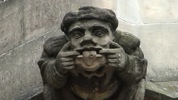…first read this:
Summary of early modern theatres and theatre goers.
This account, which dates from 1596-1598, is probably the single most important source of our knowledge of the internal layout of the London theatres. It consists of a diary note together with a sketch of the internal layout of the Swan Theatre.
FROM THE LONDON OBSERVATIONS OF JOHANNES DE WITT
There are four amphitheatres in London so beautiful that they are worth a visit, which are given different names from their different signs. In these theatres, a different play is offered to the public every day. The two more excellent of these are situated on the other side of the Thames, towards the South, and they are called the Rose and the Swan from their signboards. There are two other theatres outside the city towards the North, on the road that leads through the Episcopal Gate called Bishopsgate in the vernacular. There is also a fifth, but of a different structure, intended for fights of animals, in which many bears, bulls, and dogs of stupendous size are held in different cages and behind fences, which are kept for the fight to provide a most pleasant spectacle to the people. The most outstanding of all the theatres, however, and the largest, is that whose sign is the swan (in the vernacular, the theatre of the swan), as it seats 3000 people. It is built out of flint stones stacked on top of each other (of which there is great store in Britain), supported by wooden pillars which, by their painted marble colour, can deceive even the most acute observers. As its form seems to bear the appearance of a Roman work, I have made a drawing of it:
Early Modern theatre owners in London were in the first show business in Europe. Granted Italy and Spain had public and private theatres. And allowed women to act female parts. But the business end of it flourished in London.
Besides the main companies of players for the City and Court, there were travelling companies working all over England and Europe. As the scene grew in London, the companies in Europe grew. Eventually these groups would take on native players. And partly on these foundations the Dutch, German, Danish and Swedish theatre worlds were inspired.
Playing was becoming acting. Poetry was in the words of some playwrights, who were truly inspired by their time. As one can always only be. A product of their time’s forms and pressures, in which one is always only a grain of sand.
No matter what rank and influence you may have. You cannot engineer a cultural revolution alone. Currents and tides in affairs nothing to do with your own, and impartial to you or your cares, sweep individuals along in an inexorable stream. Sh whoever he was, understood that, or i’m missing the point entirely when i read his works.
He was though only one man in his time. His biography portrays an entirely bland individual who doesn’t fit the profile. However you have to discount the fact that his working life of 25-35 years in the London theatre scene places him in exactly the right place to be the author of plays and poems.
His personal friendships with poets like Michael Drayton and playwrights like Ben Jonson were obviously a sham and based on subterfuge, which most willingly must have been undertaken. By them and by him. And maintained for as long as they knew each other and after their deaths if necessary. To safeguard a secret few knew and everybody except their true author benefited from.
Or it could just have been the one in the middle working slowly steadily, Growing his art with the years and collaborating with the next hot writer if needs be. Whose nature becomes more abhorrent the more I think on’t as a fake. The bare Stratfordian facts produce a yawn. Yet the Elizabethan stage must have been an exciting place to be.
Shakespeare plays and poems were hits of the booksellers stalls as well as being acted at all levels of society. Everyone in the business would have known who he was. He was living the dream. Or he was living a lie.
The earliest plays were eagerly consumed like two for one early matinees at the early 20thC cinemas. Who remembers the names of the early cinema auteurs? Or jazz for that matter? Both those industries grew out of a need for a new entertainment. As did early modern theatre. Both professionally and for amateur ends.
Now HOW can one very powerful man escape any form of scrutiny? under these very public and professional eyes that are watching this superstar of stage and booksellers ? And know or not know that WIlliam Shakespeare the schlemiel from Stratford super Avon was a cheater?
Isn’t it more likely that all these people involved in the theatre and printing world around him actually weren’t conspiring to conceal the real identity of the author. (A word which had no meaning in his time). As if they would even be anywhere close enough to know the real truth.
Bottom line is he wrote plays and poems and is mentioned for their worth. In his time, and again these people who said that, why should they lie? Why can’t the Stratford man be a diamond in the rough?
And here explore the Roman influence on the theatre of the day.The idea that early moderns had to have been to Italy to appreciate the Romans is unjustified. Roman ruins and roads were all over Early modern England. English mercenaries had fought for centuries in Italy.
But then you might want to remind yourself of the major events in the Early Modern Period. Thanks to Tom Dale Keever you can.

Leave a Reply
You must be logged in to post a comment.